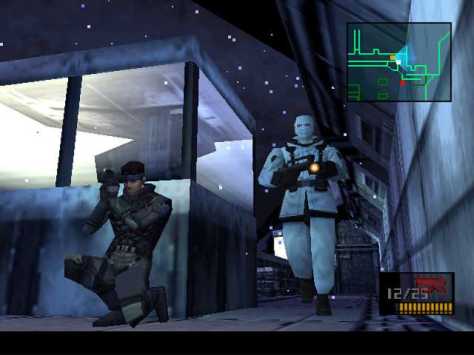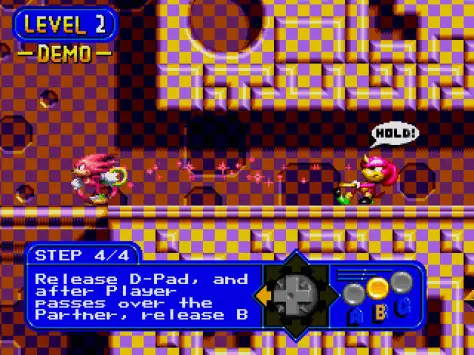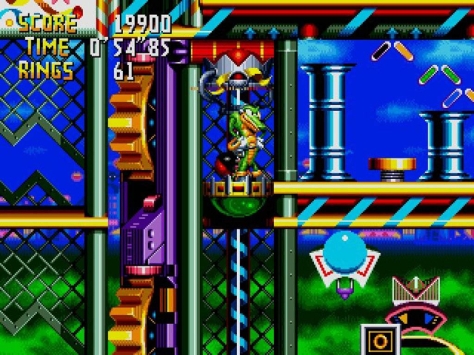
I set about this past weekend with one objective in mind: play an English-patched copy of Policenauts. In the course of attempting this, my task grew into a more general objective of playing import PlayStation and PlayStation 2 games; or rather, attempting to play them. Often, I’ll set about accomplishing something with a strong desire to see the process through only to have that yearning feeling dissipate and highlight a limited attention span and a quick-to-cave attitude. “Not this weekend!” I thought to myself. Although I remained unsuccessful on one front and only partially successful on the other, I ended the weekend with my head held high, brimming with new knowledge.
This desire to play Policenauts is not new to me, but the realization that it could be an actuality was. As my friend and I have been playing through the Metal Gear Solid series, I’ve done additional reading on the other works of Hideo Kojima. Policenauts is one such title and even though it never released in English-speaking territories, it’s still moderately known and highly regarded. Through this research, I stumbled upon the news that an enterprising group of fans had produced an English translation (circa 2007) and that it had been successfully patched into the PlayStation version (circa 2009). The process of implanting the patch didn’t seem too complex so without any additional thought, I acquired a copy off eBay… and Metal Gear Solid: Integral for good measure.
These games came in the mail this past Wednesday and before getting down to the tough stuff, I set about locating my Swap Magic discs. These are boot discs for the PlayStation 2, specifically the slim version, that allow the play of import and backup discs, with a slight modification to the console’s disc cover. I purchased these a few years ago when I first attempted to play import PS2 games. I went through the entire process of getting a slim PS2, modifying the disc cover, and finding a few games to play, only to fizzle out when I had done all the “hard” work (it was actually pretty easy). After thoroughly disassembling my gaming closet Thursday, I located the Swap Magic discs and was ready to begin processing the Policenauts patch.

Cue Friday night. My weekend had officially begun and I’d sat down at my computer to examine the readme file associated with the patch. Step one was simple: acquire a copy of Policenauts. Check. Step two upped the ante. “Rip your hard copy of Policenauts to the ISO format.” Furthermore, the author recommended CloneCD to rip the discs (it’s a two-disc game) to a .ccd format and then another program: Alcohol 120% to convert the .ccd files to .iso files. I did as he said and was successful in creating the .ccd files, after perusing that program’s help documents. I then attempted using Alcohol 120%. Before installing, it warned of compatibility issues between it and my HP laptop. I disregarded this prompt hopefully naively, and was greeted with a blue screen of death on the post-install restart. Another attempt resulted in the same issue. Through system restore, I brought my laptop back safely and was forced to look elsewhere for converting these .ccd files, read: Google.
The Google searches yielded many options for programs generating .iso files from .ccd files, but I had a hell of a time finding one (a) compatible with my HP laptop, (b) that was free or had a free trial, and (c) looked trustworthy enough to download. The incompatibility between Alcohol 120% and my HP laptop is a known issue with two solid fixes, but I didn’t feel like uninstalling the conflicting program or upgrading to Windows 10 to remedy the issue. Unfortunately, many other similar programs had similar incompatibility with HP products and my urgency to play Policenauts was beginning to waver. Fortunately, my friend demonstrated enough persistence to persuade me and I eventually discovered UltraISO, a program which granted me access to what I needed with its free trial. I now had the .iso files I needed.
The third step was another doozy: “install xdelta 3.” An innocuous enough task with even a link being provided, simple enough one might say. Wrong! Maybe it would be simple for someone who knew what they were doing. I was just following steps and as soon as the path deviated from those steps, I was lost. Whether it was the second step or this one, I had to devise my own workarounds to get to the same end result as the readme documentation. What I needed here was some kind of .exe file, of which there were many variations of, and looking back on it, I just mishandled this and started banging my head against the wall when the solution wasn’t as clear-cut as the instructions lead me to believe. To cut a long story short, I found what I needed.
With that .exe file safely tucked away in the same folder as the .iso files and the English patch, I simply had to execute the patch file and, voila! It didn’t work! But, before getting up in arms, I realized that was a possibility. There was a second patch file for computers running an Athlon CPU, which apparently I’m running, and when that was executed I was greeted with sweet, sweet success! Finally! The patch files had been applied to the .iso files and I could then burn them to blank CD-Rs and test them out in my PS2 using the Swap Magic discs. There was one single issue remaining… the Swap Magic discs don’t work with PlayStation games and backups, only PlayStation 2 games and backups. D’oh!
In a continuing display of naiveté, I realized this only after attempting to boot a CD-R and then an original disc, both unsuccessfully. A little bit of reading clarified this point to me and served as a reminder to always read the instructions fully before beginning a task (there were no instructions regarding this but I should’ve thought ahead). So, how else could I play these patched CD-Rs on actual PlayStation hardware? The readme file for the patch didn’t delve too much into that topic, but I’ve since researched a variety of options but have yet to settle on one. There’s also the simple route of just playing with an emulator, but the few times I tried doing so with ePSXe haven’t been fruitful. I’m in the process of getting that to function currently and will report back with results.
So, my weekend had barely begun when I realized that playing Policenauts likely wouldn’t be a reality. With the Swap Magic discs available and the PS2 already set up though, my friend and I turned towards the stack of import PS2 games we had hauled into the living room. Without too much effort, it was soon clear why I had fizzled out on the import scene when my interest first piqued years ago.

The Swap Magic method of playing import/backup games is pretty simple. It can only be done with a slim PS2 that has had its disc cover replaced with one resembling a toilet seat. Once the Swap Magic disc boots, it’s replaced with the desired disc which then runs as if region locking wasn’t an issue. The disc cover can’t be opened though, or else the PS2 reverts back to the browser, hence, the toilet seat design which allows for easy access. The Swap Magic discs are sold in a pair – one to boot CD based games and another to boot DVD based games.
We had no issues using the CD based Swap Magic disc. We were able to dabble with a few of the CD based games and had an enjoyable time in particular with The Zombie vs. Ambulance, or Zombie Virus as it’s known in Europe. The PS2 did not cooperate with the DVD based Swap Magic disc however. In fact, the system didn’t read any DVDs regardless of region. It was becoming clear to me why I burned out originally: because I ran into issues with DVD based games. We flat lined at this point and moved on to more productive ventures for the night.
After a night of sleep and a morning of garage sailing with my sister, I kickstarted the search for solutions to my DVD woes on Saturday afternoon. Most reading led me to believe that the laser failing to read DVDs (but still retain its CD reading functionality) was somewhat common. Cleaning the laser ruled out the potential of dust or dirt being the issue and the next cheapest option was simply replacing the laser. Luckily, I obtained a second slim PS2 at an estate last year for a pittance; alternatively, a replacement laser was about $12 on Amazon. I made sure to test a variety of CDs and DVDs in this second PS2 before going any further and fortunately, all worked. After watching a few YouTube tutorials on replacing the laser I had confidence that I was up to the task.
Later that night, while watching Dr. Zhivago on the OETA Movie Club, I successfully switched the lasers. It took much longer than it should’ve thanks to the distraction of the movie but there were also a couple of screws that were royal pains in the butt to remove. Once the movie had finished I had the opportunity to test out the modified PS2 and… it still didn’t play the Swap Magic DVD! What’s more, the system successfully played other DVDs. Looking on the bright side, my issues were narrowed down more specifically to the DVD based Swap Magic disc itself. It didn’t look too scratched, although there were minute cosmetic issues with the disc. Getting it resurfaced would either solve the problem or eliminate one more possibility.
Sunday afternoon, once they’d opened, I made the drive to the nearest Vintage Stock with a working resurfacing machine. While waiting I stumbled across an older GameShark for the PlayStation. In the reading I’d done on playing import/backup copies of PlayStation games I saw mention of an exploit that might possibly allow me to play Policenauts. I bought it to be on the safe side but realized when I arrived home that it wasn’t compatible with my PlayStation. Policenauts was again put on the backburner, but I was one step closer! Next up on the docket was testing the newly resurfaced DVD based Swap Magic disc.
To my surprise, it worked! The PS2 successfully read the disc and launched the Swap Magic menu. I exchanged the disc for Michigan, a Grasshopper Manufacture survival horror game that I remembered seeing on X-Play years ago. The involvement of Suda51 may have also had an impact on my purchase too… Side note: this game was released in Europe, but good luck finding a copy for under $40 and let me know if you do! I was appeased after a little while and was ready to try another game when the PS2 stopped booting the Swap Magic disc. It recognized it as a PS2 disc in the browser and would act like it was booting it, only to return me to the browser menu. ARGH! Other DVDs played just fine so I’m led to believe there’s an issue with the disc itself – not the surface of it, but the information that’s written to it, so… yeah.
I can’t explain why it worked once and not again other than just getting lucky, but I’m not going to sweat it. Maybe I’ll get a plan of action assembled for this upcoming weekend, maybe I’ll have these issues resolved before then, or maybe I won’t even bother and just fizzle out entirely here. No, after all I’ve been through I know I won’t take the easy route out, I’m going to see my objectives through. I’ve been constantly disheartened through these two procedures, but I’ve consistently found ways to make something work or narrow my issues down. Whether it’s playing an English-patched copy of Policenauts or playing DVD based, import PS2 games, I can look back at this weekend disappointed that I wasn’t entirely successful, but I can also look back at it and be proud of the work I put in and the knowledge I’m left with. This weekend was a learning experience that things won’t always be as easy as they seem, but that’s no reason to give up. The path to success is lined with trial and error and through that process, much can be gained.

![Castlevania: Portrait of Ruin [Nintendo DS] – Review](https://mybrainongames.files.wordpress.com/2015/09/castlevania-portrait-of-ruin.jpg?w=672&h=372&crop=1)





![Metal Gear Solid [PlayStation] – Review](https://mybrainongames.files.wordpress.com/2015/09/metal-gear-solid.jpg?w=672&h=372&crop=1)





![Fallout Shelter [Android] – Review](https://mybrainongames.files.wordpress.com/2015/09/fallout-shelter.jpg?w=672&h=372&crop=1)





![Roxio Game Capture HD Pro [Review]](https://mybrainongames.files.wordpress.com/2015/09/roxio-game-capture-hd-pro.jpg?w=672&h=372&crop=1)


![Star Ocean: Second Evolution [PlayStation Portable] – Review](https://mybrainongames.files.wordpress.com/2015/09/star-ocean-second-evolution.jpg?w=672&h=372&crop=1)





![Knuckles’ Chaotix [Sega 32X] – Review](https://mybrainongames.files.wordpress.com/2015/08/knuckles-chaotix.jpg?w=672&h=372&crop=1)




